Search This Blog








Soft Wild Rose Memory Blog.
The vision for Soft Wild Rose Memory Blog,
immerses a natural lifestyle, a calm & vivid oasis, while embracing
nature, learning, harmony, savoring, meditation,
and also it involves nurturing the subconscious
& senses with healing, nurturing imagery, inspiration..
- Soft Wild Rose Memory. {Music} Posts
- Add Cinnamon flower :) Powder To Your Tea and Coffee And This Will Happen
- Aman Hanoi
- Drinking tea at a traditional Korean Tea House (전통 찻집) in Insadong, Seoul, Korea
- Le Mirador, Montreux, Switzerland
- JAPANESE TEA FARM IN SHIZUOKA����
- Maesil extract (Maesil-cheong) is used widely in traditional Korean cuisine as a sweetener. It's made from maesil (aka green plums) Japanese apricot
- Soft Wild Rose Memory. {Birdsong) Posts
- Soft Wild Rose Memory, {Health Posts}
- Soft Wild Rose Memory., {Organic Life} Posts
- Mariage D'Amour
- Masai Mara - safari adventure in a wildlife paradise - Predators, big herds and wildebeest migration
- Old Town of Lijiang, Yunnan, China)
- Oriental Posts, Soft Wild Rose Memory
- The Ryokan Collection
Soft Wild Rose Memory. All Postings.
Soft Wild Rose Memory. All Postings.
-
-
-
-
-
-
-
-
- 0:59 / 3:01 Elephants at Anantara Resort Chiang Ra...
- 0:21 / 2:19 Four Seasons Resort Chiang Mai (Thaila...
- Aman Residences, Amanzoe Resort, Porto Heli, Greece
- AMANZOE: BEST LUXURY RESORT IN GREECE (PHENOMENAL!)
- Relax at Qasr Al Sarab - قصر السراب: أجواء تبعث عل...
- Nick and Jessica::Chicken by the Sea part 1
- 0:26 / 10:27 Nick and Jessica Jessica's Romantic D...
- Nick and Jessica Nick's 30th Birthday Part 1
- watching romantic couples that have just amazing n...
- Bath Music, Massage Music, Relax Spa Bath Music, R...
- I feel my own hammam would be wonderful..i think i...
- i love long candle-light, sensual baths, touched i...
- One of my favorite forever scents..especially beca...
- Paris is beautiful really any season..especially w...
- A Visit to the Île de la Cité
- ....
- 0:13 / 0:15 Budapest, Hungary | Fairytale City
- i want the fairytale...
- English Cottage and Country Gardens
- Truly special townhouses like this are so lovely.....
- Luxury Bath Spa Sounds: Shiatsu & Reiki Healing Mu...
- Good Morning Music....
- 0:17 / 0:43 Château Saint-Martin & Spa - Spa Saint...
- Best luxury Spa destination in Europe - Château Sa...
- Château Saint-Martin & Spa - History restyled
- .....
- 0:00 / 0:44 Château Saint-Martin & Spa - L'Oliveraie
- I really have this talent for discovering what is ...
- Chef Jean-Luc Lefrançois - Château Saint-Martin & Spa
- I really want to have extended weeks here this sum...
- 0:52 / 1:07 Discover the Flavors of the French Riv...
- “Your heart does not need protection, it is your b...
- This Baby Goat Montage Is the G.O.A.T.
- There is a lovely artistry to something abandoned,...
- 0:18 / 5:11 Victoria Ellis Carves Fine Bas Relief ...
- This 1800s Love Story Is Full Of Your Favorite Act...
- MARIAGE D'AMOUR - Richard Clayderman
- 0:27 / 1:38:06 Woman of the River (The River Girl)...
- 0:24 / 2:21 English afternoon tea etiquette
- 396Hz ❯ Cleanses Fear Negative Energy - Stop Stres...
- 3 HOURS of Relaxing Cafe JAZZ ~ Smooth Jazz Instru...
- i still love and remember the moments with a boy t...
- A research conducted on traditional medicinal know...
- Soneva Kiri (Thailand), world's most AMAZING hotel...
- Cute Baby Goats - A Cutest And Funny Goats Baby Vi...
- ....
- Amanruya (Bodrum, Turkey): impressions & review
- Seasonal Berries Sparkling Water
- Deep Sleep Piano Instrumental Forest Healing music...
- Rain is truly so beautiful and relaxing for us...:...
- I feel...
- “Normally, Edward would have found intrusive, clin...
- Deep Healing Music: Release Toxic Energy, Let Go O...
- There is nowhere really as untampered and beautifu...
- How pretty is this night sky & rushing poetic oce...
- c'est moi ;)
- Briseis and Achilles (From "Troy")
- Liszt I discovered later on in life, but his roman...
- For me the beauty of life is often in the moments ...
- 0:23 / 2:00 Ocean Sounds and Forest Nature Sound: ...
- One of my favorite photos and decorative pieces in...
- Still some of my favorite photos of me...captured ...
- I really cannot wait to have wild & beautiful wild...
- i actually really love Jackie...as she was a truly...
- What does it Mean to be a Lady Today?
- .....
- 15 EASY DIY NATURAL BEAUTY HACKS YOU NEED TO TRY!
- Beauty In A Jar (Documentary)
- Beauty is in the eye of the beholder, according to...
- 0:41 / 38:38 Love & Drugs in Victorian London - El...
- Top 10 Scary Tomb Stone Messages
- Old Master Painting Conservation
- The golden Art of Gustav Klimt
- The classic portraits of John Singer Sargent
- Gustav Klimt (July 14, 1862 – February 6, 1918) wa...
- 0:28 / 4:01:16 Documentary - Western Philosophy, P...
- "Soldiers understand nothing but war, peace confus...
- Do you know for some moments i really wanted to le...
- Achilles and Briseis. Troy. With subtitles.
- 0:41 / 1:00:07 Great Gardens of England
- How a Traditional Education Benefits Your Child
- Why Finland has the best education system in the w...
- Water Infuser Pitcher
- What if everyone had a classical education? | Rebe...
-
-



Artisan+Appreciative+Savoring Lifestyle, of Western & Eastern philosophy, approach, art, song, wellbeing, design... “You were born a child of light’s wonderful secret— you return to the beauty you have always been.”



Soft Wild Rose Memory Blog.














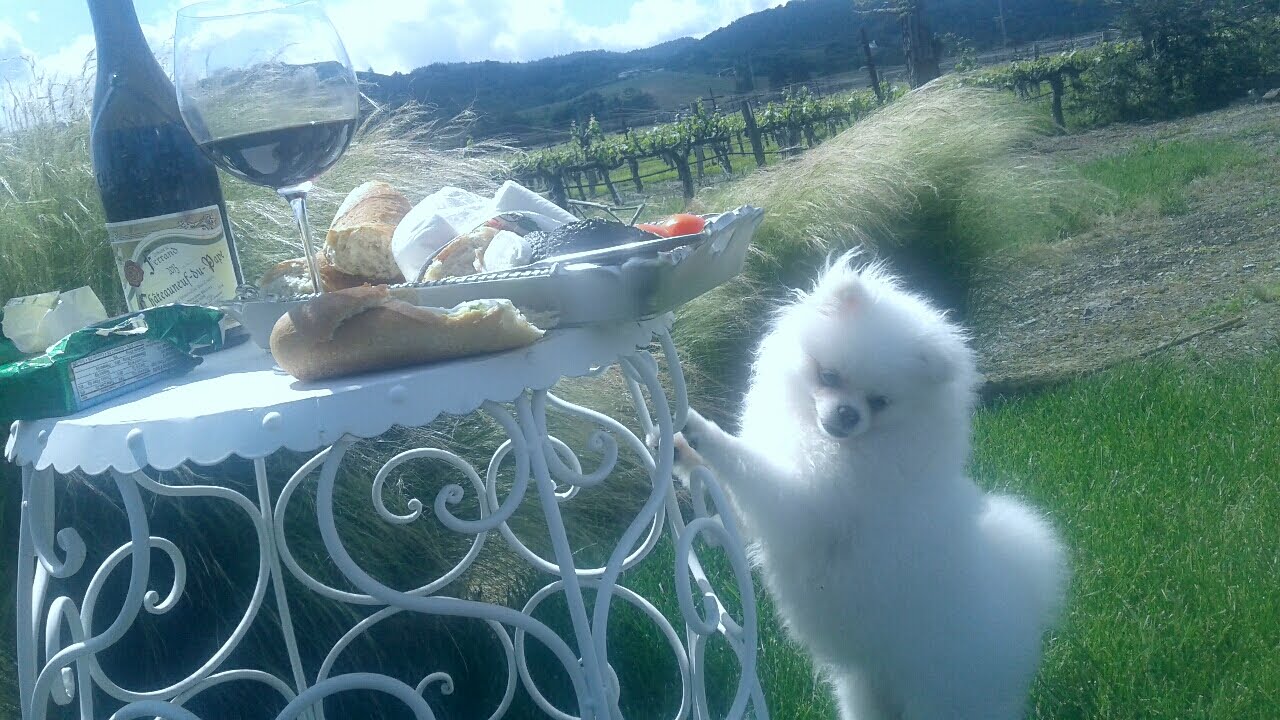
Remember...
"Remember the life...and the flowers..."
-Lilia Kalinina...
Love the world as your own self; then you can truly care for all things. Lao Tzu
....
"When one tugs at a single thing in nature, he finds it attached to the rest of the world." John Muir
Soul...
"Oh...but the soul speaks...it always speaks..."
-Lilia Kalinina

Life...
“Two things you will never have to chase: True friends & true love.”
― Mandy Hale
― Mandy Hale
― C. JoyBell C.
“You only need one man to love you. But him to love you free like a wildfire, crazy like the moon, always like tomorrow, sudden like an inhale and overcoming like the tides. Only one man and all of this.”
― C. JoyBell C.
― C. JoyBell C.
Nature...
"The lover of nature is he whose inward and outward senses are still truly adjusted to each other; who has retained the spirit of infancy even into the era of manhood. His intercourse with heaven and earth, becomes part of his daily food. " Ralph Waldo Emerson






Popular Posts
Beauty and the Beast (1991) Scene: The Library Surprise
- Get link
- X
- Other Apps
Celebrating the launch of Iris Prima, our enchanting ballet flash mob took place on Thursday 26th of September 2013, at Saks Fifth Avenue in New York. With special thanks to the Jacqueline Kennedy Onassis School at American Ballet Theatre.
- Get link
- X
- Other Apps
The saponins and alkaloids found in jujube fruit have been directly linked with purifying the blood and eliminating harmful toxins from the body’s systems. [15] This antioxidant effect can help prevent a large number of diseases and also ease the stress on the immune and lymphatic systems.
- Get link
- X
- Other Apps
Connecticut is really so beautiful, charming, inviting :)
- Get link
- X
- Other Apps
0:26 / 2:25 French Press ile kahve nasıl demlenir?
- Get link
- X
- Other Apps

Wikipedia
Search results
Translate
- Get link
- X
- Other Apps
Pakistani cuisine (Urdu: پاکستانی پکوان) can be characterized by a blend of various regional cooking traditions of the Indian subcontinent, Central Asia as well as elements from its Mughal legacy.[1][2] The various cuisines are derived from Pakistan's ethnic and cultural diversity.
Pakistani cuisine
From Wikipedia, the free encyclopedia
This article needs additional citations for verification. Please help improve this article by adding citations to reliable sources. Unsourced material may be challenged and removed.
Find sources: "Pakistani cuisine" – news · newspapers · books · scholar · JSTOR (November 2011) (Learn how and when to remove this template message) |
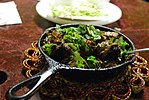 |
| This article is part of the series |
| Pakistani cuisine پاکستانی پکوان |
|---|
Regional cuisines[show]
|
Ingredients[show]
|
Preparation and cooking[show]
|
See also[show]
|
| Part of a series on the |
| Culture of Pakistan |
|---|
 |
| Traditions |
Mythology and folklore[show]
|
| Cuisine |
Music and performing arts[show]
|
| Sport |
Monuments[show]
|
Pakistani cuisine (Urdu: پاکستانی پکوان) can be characterized by a blend of various regional cooking traditions of the Indian subcontinent, Central Asia as well as elements from its Mughal legacy.[1][2] The various cuisines are derived from Pakistan's ethnic and cultural diversity.
Cuisine from the eastern provinces of Punjab and Sindh are characterized as "highly seasoned" and "spicy", which is characteristic of flavors of the Indian subcontinent. Cuisine from the western and northern provinces of Azad Jammu & Kashmir, Balochistan, Gilgit-Baltistan, Khyber Pakhtunkhwa and the Tribal Areas are characterized as "mild" which is characteristic of flavors of the Central Asian region.
International cuisine and fast food are popular in the cities. Blending local and foreign recipes (fusion food), such as Pakistani Chinese cuisine, is common in large urban centers. Furthermore, as a result of lifestyle changes, ready made masala mixes (mixed and ready to use spices) are becoming increasingly popular. However, given the diversity of the people of Pakistan, cuisines generally differ from home to home and may be different from the mainstream Pakistani cuisine.
Contents
Historical influences[edit]
Main article: History of Pakistani cuisine
Pakistani national cuisine is the inheritor of Indo-Aryan and Iranic culture and Muslim culinary traditions. The earliest formal civilizations were the Mohenjo-daro (موئن جو دڑو) and Harappan civilizations in Pakistan. At around 3000 BCE, sesame, eggplant, and humped cattle were domesticated in the Indus Valley,[3]and spices like turmeric, cardamom, black pepper and mustard were harvested in the region concurrently.[4] For at least a thousand years, wheat and rice formed the basic foodstuff in the Indus Valley.[5]
The arrival of Islam (اسلام) within the Indian subcontinent, influenced the local cuisine to a great degree. Since Muslims are forbidden to eat pork (سور) or consume alcohol, halal (حلال) dietary guidelines are strictly observed. Pakistanis focus on other types of meat, such as beef, chicken and fish, with vegetables, as well as traditional fruit and dairy. The influence of Central Asian, South Asian and Middle Eastern cuisine in Pakistani food is ubiquitous.[citation needed]
Elements[edit]
Main articles: Origins of Pakistani foods, List of Pakistani spices, and List of plants used in Pakistani cuisine
Pakistani dishes are known for having aromatic and sometimes spicy flavors. Some dishes contain liberal amounts of oil, which contribute to a richer, fuller mouthfeel and flavour. Brown cardamom, green cardamom, cinnamon, cloves, nutmeg, mace, and black pepper are the most commonly used spices in the making of a wide variety of dishes throughout Pakistan. Cumin seeds, chili powder, turmeric and bay leaves are also very popular. In the Punjab province, it is further diluted with coriander powder. Garam masala (a mixture of aromatic spices) is a very popular blend of spices used in many Pakistani dishes.
Regional cuisines[edit]
Balochistan[edit]
Main article: Balochi cuisine
Balochi cuisine is the food and cuisine of the Baloch people from the Balochistan region, comprising the Pakistani Balochistan province, the Sistan and Baluchestan Province in Iran and Balochistan, Afghanistan. Baloch food has a regional variance in contrast to the many cuisines of Pakistan[6][7] and Iran.
Khyber Pakhtunkhwa[edit]
Main article: Pashtun cuisine
Rice dishes and kebabs feature prominently in Pashtun cuisine. Lamb is eaten more often in Pashtun cuisine than any other Pakistani cuisines. Rice haleem, chapli kabab, tika, and mutton karahi are the most famous dishes. Historical variations include Peshawari cuisine. The Pashtun and Balochi cuisines are traditionally non-spicy.
Kalash[edit]
Main article: Kalash cuisine
Hunza[edit]
See also: Hunza diet
This section is empty. You can help by adding to it. (March 2018)
|
Kashmir[edit]
Main article: Kashmiri cuisine
Main article: Balti (food)
Kashmiri cuisine is the cuisine of the Kashmir Valley region. Rice is the staple food of Kashmiris and has been so since ancient times. Meat (chicken, mutton, beef, or fish), along with rice, is the most popular food item in Kashmir. Kashmiris consume meat voraciously.
Punjab[edit]
Main article: Punjabi cuisine
Since Punjabi identity is considered geographical and cultural, almost all inhabitants of Punjab follow some variations within the cuisine, but on the other hand show many similarities together. This cuisine then falls into the broad category of Punjabi cuisine. Regional cuisine is mutual with some differences in many regions, including the South Punjab regions.
South Punjab[edit]
Main article: Saraiki cuisine
Sindh[edit]
Main article: Sindhi cuisine
Sindhi cuisine refers to the native cuisine of the Sindhi people from Sindh, Pakistan. Sindhi Cuisine is considered to be spicy and consists of a variety of chicken dishes.
Karachi[edit]
Main article: Cuisine of Karachi
The cuisine of Karachi is similar to the Mughlai cuisine, which is influenced by Hyderabadi cuisine.
Meal structure[edit]
Pakistanis generally eat three meals a day, which are breakfast, lunch, and dinner. During the evening, many families have tea, which goes along with baked/fried snacks from a local bakery (or prepared at home). During the Islamic holy month of Ramadan, the eating patterns change to Suhur and iftar. It is considered proper to eat only with the right hand as per Islamic tradition (also a tradition in many other Asian cultures). Many Pakistani families, particularly when guests are too many to fit at a table, eat sitting at a cloth known as Dastarkhān, which is spread out on the floor. In Pakistan, many street eateries serve food on a takht, in a style similar to what is seen in Afghanistan. A takht is a raised platform, where people eat their food sitting cross-legged, after taking their shoes off. Most Pakistanis used to eat on a takht. Pakistanis often eat with their hands, scooping up solid food along with sauce with a piece of baked bread (naan) or rice.
Breakfast[edit]
A typical Pakistani breakfast, locally called nāshtā (ناشتہ), consists of eggs (boiled/scrambled/fried/omelette), a slice of loaf bread or roti, parathas, sheermal with tea or lassi, kulcha with chole, qeema (minced meat), fresh seasonal fruits (mangoes, apples, melons, bananas, etc.), milk, honey, butter, jam, shami kebab or nuts. Sometimes breakfast includes baked goods like bakarkhani and rusks. During holidays and weekends, halwa poori and chickpeas are sometimes eaten. In Punjab, sarson ka saag (mustard leaves) and maakai ki roti (cornbread) is a local favourite. Punjabi people also enjoy khatchauri, a savory pastry filled with cheese. Pakistan is not unlike many other Asian nations, in the sense that meat dishes are eaten as breakfast, especially on holidays. A traditional Sunday breakfast might be Siri-Payay (the head and feet of lamb or cow) or Nihari (a dish which is cooked overnight to get the meat extremely tender. The name "Nihari" comes from the Arabic word "Nihar", meaning "Day" or "Day break".) Many people used to take "Bong" (Shank curry) in their Sunday brunch.
Lunch[edit]
A typical Pakistani lunch consists of meat curry along with rice or a pile of roti. Daal chawal is among the most commonly taken dishes at lunch. Breads such as roti or naan are usually served for dinner, but have become more common during the day so that rice may be served for dinner. Popular lunch dishes may include aloo gosht (meat and potato curry) or any vegetable with mutton. Chicken dishes like chicken karahi are also popular. Alternatively, roadside food stalls often sell just lentils and tandoori rotis, or masala stews with chapatis. People who live near the main rivers also eat fish for lunch, which is sometimes cooked in the tandoori style.
Dinner[edit]
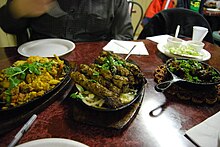
A variety of Pakistani dinner dishes – Starting from the left: gobi aloo, seekh kebab, and beef karahi
Dinner is considered the main meal of the day as the whole family gathers for the occasion. Food which requires more preparation and which is more savoury (such as biryani, nihari, pulao, kofte, kebabs, qeema, korma) are prepared. Lentils are also a dinnertime staple. These are served with roti or naan along with yogurt, pickle and salad. The dinner may sometimes be followed by fresh fruit, or on festive occasions, traditional desserts like kheer, gulab jamun, shahi tukray, gajraila, qulfi or ras malai.
Snacks and Fast Foods[edit]
Main articles: Pakistani snack foods and Pakistani fast food
Pakistani snacks comprise food items in Pakistan that are quick to prepare, spicy, usually fried, and eaten in the evening or morning with tea or with any one of the meals as a side dish. A given snack may be part of a local culture, and its preparation and popularity can vary from place to place. These snacks are often prepared and sold by hawkers on footpaths, railway stations and other such places, although they may also be served at restaurants. Some typical snacks are Dahi Bhala, Aloo tikki, chaat & Samosa Chaat, Bun kebab, Chana Masala, Chapli kebab, Shami kebab, Seekh Kebab, Malai Tikka Kebab (Meat and Yogurt), Reshami Kebab, Pakora, and Papar. Others include Katchauri, pakoras—either neem pakoras or besan (chickpea) Pakoras, Gol Gappay, Samosas—vegetable or beef, Bhail Puri, Daal Seu, Panipuri, and egg rolls. Nuts, such as pistachios and pine nuts, are also often eaten at home.
Main courses[edit]
In Pakistan, main courses are usually served with wheat bread (either roti or naan) or rice. Salad is generally taken as a side dish with the main course, rather than as an appetizer beforehand. Assorted fresh fruit or sometimes desserts are consumed at the end of a meal.[citation needed] Meat plays a much more dominant role in Pakistani food, compared to other South Asian cuisines. According to a 2003 report, an average Pakistani consumed three times more meat than an average Indian.[8] Of all the meats, the most popular are goat, mutton, beef and chicken, which are particularly sought after as the meats of choice for kebab dishes or the classic beef shank dish nihari. Seafood is generally not consumed in large amounts, though it is[9] very popular in the coastal areas of Sindh and the Makrancoast of Balochistan and was a dominant element of the cuisine of the former East Pakistan (now Bangladesh).
Curries, with or without meat, combined with local vegetables, such as bitter gourd, cauliflower, eggplant, okra, cabbage, potatoes, rutabaga, saag, and chili peppers are most common and cooked for everyday consumption. A typical example is aloo gosht (literally "potatoes and meat"), a homestyle recipe consisting of a spiced meat and potato stew, and is ubiquitously prepared in many households. Korma is a classic dish of Mughlai origin made of either chicken or mutton, typically eaten with naan or other bread, and is very popular in Pakistan.
Vegetable and legume dishes[edit]
Main articles: Pakistani vegetable dishes and Pakistani legume dishes
Vegetable and legume dishes are very popular in Pakistan. Dishes such as Baingan bartha and Sarson da saag are typical examples eaten in most homes.
Meat dishes[edit]
The meat dishes in Pakistan include bovine, ovine, poultry and seafood dishes. The meat is usually cut in 3 cm cubes and cooked in a stew. The minced meat is used for Kebabs, Qeema, and other meat dishes. The meat dishes are also cooked with pulses, legumes and rice.
Barbecue and kebabs[edit]
Meat and grilled meat have played an important role in Pakistan for centuries. Kebabs are a staple item in Pakistani cuisine today, and one can find countless varieties of kebabs all over the country. Each region has its own varieties of kebabs, but some like the Seekh kebab, Chicken Tikka, and Shami kebab are especially popular throughout the country and in some other parts of South Asia.
- A variety of dishes cooked by barbecuing
- Seekh kebab (minced meat on skewers), a famous Pakistani food specialty
- Chapli kebab is another famous Pakistani food specialty
Pulses[edit]
Main article: Pakistani lentil dishes
Various kinds of pulses or legumes, make up an important part of Pakistani cuisine. While lentils (called daal) and chickpeas (called channa) are popular ingredients in homestyle cooking, they are traditionally considered to be inexpensive food sources. Because of this reason, they are typically not served to guests who are invited for dinner or during special occasions. Combining meat with lentils and pulses, whether in simple preparations or in elaborate dishes such as haleem.
Beans such as black-eyed peas (lobia) and kidney beans (rajma) are sometimes served in a tomato-based masala sauce, especially in Punjab.
Rice dishes[edit]
Main article: Pakistani rice dishes
Pakistan is a major exporter and consumer of rice. Basmati is the most popular type of rice consumed in Pakistan.
Dishes made with rice include many varieties of pulao:
- Maash pulao - A sweet and sour pulao baked with mung beans, apricots and bulgur (a kind of roughly milled cracked wheat). Exclusively vegetarian.
- Matar pulao - Pulao made with peas.
- Murgh pulao - Chicken and stock added. Creates a brown rice.
- Yakhni pulao - Meat and stock added. Creates a brown rice.
- Kabuli Palaw - is an Afghan dish, which is popular in Pashtun dominated regions in Pakistan such as the Tribal Areas, FATA, Khyber Pakhtunkwa province in North-West Pakistan, and Balochistan in the South-West Pakistan. It is a variety of pilaf, consisting of steamed rice mixed with raisins, carrots, and lamb
Biryani is a very popular dish in Pakistan, and has many varieties, such as Lahori and Sindhi biryani. Tahiri, which is a vegetarian form of biryani, is also popular. All of the main dishes (except those made with rice) are eaten alongside bread. To eat, a small fragment of bread is torn off with the right hand and used to scoop and hold small portions of the main dish. Pickles made out of mangoes, carrots, lemon, etc. are also commonly used to further spice up the food.
In the Khyber-Pakhtunkhwa, feasts using mountains of spiced rice combined with pieces of slowly roasted lamb are often served for guests of honour. These kind of pulaos often contain dried fruit, nuts, and whole spices such as cloves, saffron and cardamom. Kabuli Palaw is very popular in Pashtun dominated regions in Western Pakistan. Such rice dishes have their origins in Central Asia and the Middle East.
Varieties of bread[edit]
Pakistanis eat breads made of wheat flour as a staple part of their daily diet. Pakistan has a wide variety of breads, often prepared in a traditional clay oven called a tandoor. The tandoori style of cooking is common throughout rural and urban Pakistan, and also has strong roots in neighboring India, Iran and Afghanistan. Some of these are:
- Chapati - Most common bread made in urban homes, where a tandoor is not available. Chapatis are cooked over a flat or slightly convex dark colored pan known as 'tava'. Chapatis are made of whole wheat flour and are thin and unleavened. Tortillas are probably the most common analogous to chapatis, though chapatis are slightly thick. A variant, known as 'romali roti' (lit. Handkerchief bread), is very thin and very large in size.
- Kandahari Naan - Long, salty naan originating in Western Pakistan and commonly eaten with Peshawari Karahi or Chapli Kebab.
- Kulcha - This is a type of naan usually eaten with chickpeas and potatoes and mostly popular in urban centers of Punjab.
- Naan - In Urdu, the national language of Pakistan, the word Naan means bread. Unlike chapatis, naans are slightly thicker, typically leavened with yeast and mainly made with white flour. Some varieties like Roghani and Peshwari naan may also be sprinkled with sesame seeds. Naans are seldom, if ever, made at home since they require tandoor based cooking and require prep work. Numerous varieties of plain, as well as stuffed naans are available throughout Pakistan and each region or city can have their own specialty. Naan is a versatile bread and is eaten with almost anything. For instance, 'saada naan' or 'plain naan', is often served with Siri-Payay (cow's head and trotters) or Nihari (slow cooked beef stew) for breakfast in many parts of the country.
- Paratha - A flat, layered bread made with ghee and generally cooked on a 'tava'. However, a 'tandoor' based version is also common in rural areas. Parathas are very similar to pastry dough. Parathas most likely originated in the Punjab, where a heavy breakfast of parathas with freshly churned butter and buttermilk was commonly consumed by the farmers to prepare themselves for the hard day of work ahead. However, parathas are now a common breakfast element across the country. Along with the plain layered version, many stuffed versions, such as 'Aloo ka Paratha' (Potato stuffed paratha), 'Mooli ka Paratha' (Radish stuffed paratha), and 'Qeemah ka Paratha' (Ground meat stuffed paratha) are popular.
- Puri - This is a breakfast bread made of white flour and fried. Typically eaten with sweet semolina halwa or gravy (made out of chickpeas and potatoes). Puri is a fairly urban concept in Pakistan and puris are not part of rural cuisine anywhere in Pakistan. However, Halwa Puri has now become a favored weekend or holiday breakfast in urban Pakistan, where it is sometimes sold in shift carts or in specialty breakfast shops.
- Roghani Naan (lit. Buttered Naan) - It is a preferred variety of Naan sprinkled with white sesame seeds and cooked with a small amount of oil.
- Roti - This bread is extremely popular all over Pakistan. Tandoori rotis are baked in a clay oven, known as a tandoor, and are consumed with just about anything. In rural Pakistan, many houses have their own tandoors, while the ones without it use a communal one. In urban Pakistan, bread shops or "nanbai"/"tandoor" shops are fairly common and supply fresh, tandoor baked breads to household customers.
- Sheermal – Saffron-flavored traditional flatbread. It is a festive bread prepared with milk ('sheer') and butter with added candied fruits. Sheermal is often a vital part of food served in marriages, along with taftan. It is often sweetened.
- Taftan - This is a leavened flour bread with saffron and a small amount of cardamom powder baked in a tandoor. The taftan made in Pakistan is slightly sweeter and richer than the one made in neighboring Iran.
Desserts[edit]
Main articles: List of Pakistani desserts and Pakistani sweets
Popular desserts include Peshawari ice cream, sheer khurma, qulfi, falooda, kheer, feerni, zarda, shahi tukray and rabri. Sweetmeats are consumed on various festive occasions in Pakistan. Some of the most popular are gulab jamun, barfi, ras malai, kalakand, jalebi and panjiri. Pakistani desserts also include a long list of halvah, such as multani, hubshee, and sohan halvah.
Kheer made of roasted seviyaan (vermicelli) instead of rice is popular during Eid ul-Fitr. Gajraila is a sweet made from grated carrots, boiled in milk, sugar, and green cardamom, topped with nuts and dried fruit. It is popular in Pakistan, as well as in other parts of South Asia, including Afghanistan.
Tea varieties[edit]
Main article: Pakistani tea culture
Pakistanis drink a great deal of tea, which is locally called "chai." Both black (with milk) and green teas are popular and there are different varieties common in different parts of Pakistan.
- In Gilgit-Baltistan and Chitral, as well as areas near the Chinese border, salty Tibetan-style butter tea is consumed.
- Doodh Pati Chai is made by cooking tea leaves with milk and sugar, sometimes served with cardamom for fragrance. Extremely sweet, this is a local variation of a builder's tea.
- "Kashmiri chai" or "noon chai", a pink, milky tea with pistachios and cardamom, is consumed primarily at special occasions, weddings, and during the winter, when it is sold in many kiosks.
- "Sabz chai" or "kahwah", a green tea often served after every meal in Kashmir, Khyber Pakhtunkhwa, and the Pashtun belt of Balochistan, served with saffron and nuts.
- Sulaimani chai is black tea served with lemon.
Beverages[edit]
Besides tea, there are other drinks that may be included as part of the Pakistani cuisine. All of them are non-alcoholic as the consumption of alcohol is prohibited by Islam. During the 20th century, beverages such as coffee and soft drinks have also become popular in Pakistan. It is very common to have soft drinks nowadays with Pakistani meals.
- Almond sherbet - Sherbet made with almonds
- Gola ganda - Different types of flavors over crushed ice
- Kashmiri chai/Gulabi chai - A milky tea known for its pink color, with an either sweet or salty taste
- Lassi - Milk with yogurt, with an either sweet or salty taste
- Lemonade (Limu pani)
- Qehwa - Green tea with cardamom
- Sardai - Mixture of different nuts and kishmish
- Sathu - Famous drink from Punjab
- Sherbet (syrup mixed in water)
- Sherbet-e-Sandal - Drink made with the essence of sandal wood
- Sikanjabeen - Lemonade (mint is also added)
- Sugarcane juice (Ganney ka ras)
- Thaadal - A sweet drink from Sindh
Halal[edit]
Main article: Halal
Muslims follow the Islamic law that lists foods and drinks that are Halal and permissible to consume. Halal foods are food items that Muslims are allowed to eat and drink under Islamic dietary guidelines. The criteria specify both what foods are allowed, and how the food must be prepared. The foods addressed are mostly types of meat, which are allowed in Islam.
Foreign influences[edit]
Occasionally, many people in Pakistan have dinner outside at a restaurant with foreign influenced food, such as Western, Arab and Chinese dishes. Many westernized, Chinese restaurants and fast food outlets are dotted in all urban parts of Pakistan. The Punjab and Sindh provinces, where the majority of urban chains of many American, European and British restaurants have opened in many metropolitan cities, such as Karachi, Lahore, Islamabad, Hyderabad, Sialkot, Faisalabad, Multan, Rawalpindi, and many others. Marketing and advertisements have made these a haven for social and modern spots for all Pakistanis to try out.
Outside Pakistan, Pakistani cuisine is prevalent in countries, where they have large Pakistani communities. The Balti curry is a British dish that is claimed to have origins in the Kashmir region of Pakistan.
Pakistani food makes use of fresh hand-pounded masalas. Ghee is used, but the main component of the meal or a dish is meat (beef, lamb, chicken, goat, or fish), and vegetables are sparingly used. Surprisingly, Pakistani food also makes extensive use of olive oil. Sparingly used vegetables does not mean there is no vegetarian food on the menu. Since the cuisine is very similar to Punjabi-style of cooking, tikka, simmered dals, tawa sabzi, and chaat feature here.[10]
See also[edit]
- Get link
- X
- Other Apps
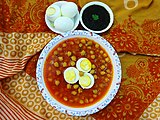


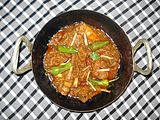

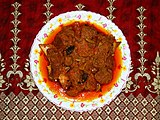
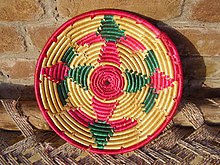

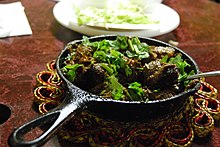


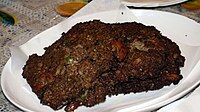


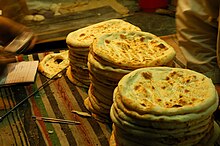

Comments
Post a Comment